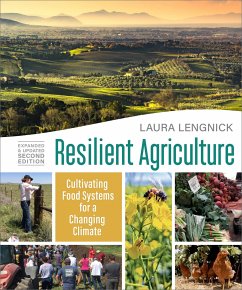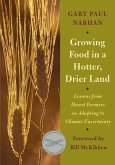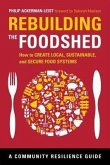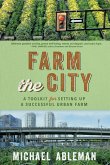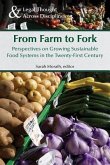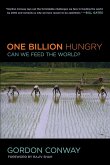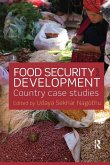Laura Lengnick
Resilient Agriculture: Expanded & Updated Second Edition
Cultivating Food Systems for a Changing Climate
Laura Lengnick
Resilient Agriculture: Expanded & Updated Second Edition
Cultivating Food Systems for a Changing Climate
- Broschiertes Buch
- Merkliste
- Auf die Merkliste
- Bewerten Bewerten
- Teilen
- Produkt teilen
- Produkterinnerung
- Produkterinnerung
Resilient Agriculture, Second Edition explores the latest science on climate risk and resilience through the adaptation stories of award-winning farmers and ranchers to explore the powerful solutions offered by agriculture and food systems designed to restore the natural, human, and social resources that sustain us.
Andere Kunden interessierten sich auch für
![Growing Food in a Hotter, Drier Land Growing Food in a Hotter, Drier Land]() Gary Paul NabhanGrowing Food in a Hotter, Drier Land31,99 €
Gary Paul NabhanGrowing Food in a Hotter, Drier Land31,99 €![Rebuilding the Foodshed Rebuilding the Foodshed]() Philip Ackerman-LeistRebuilding the Foodshed23,99 €
Philip Ackerman-LeistRebuilding the Foodshed23,99 €![The Doubly Green Revolution The Doubly Green Revolution]() Gordon ConwayThe Doubly Green Revolution24,99 €
Gordon ConwayThe Doubly Green Revolution24,99 €![Farm the City Farm the City]() Michael AblemanFarm the City18,99 €
Michael AblemanFarm the City18,99 €![From Farm to Fork From Farm to Fork]() From Farm to Fork21,99 €
From Farm to Fork21,99 €![One Billion Hungry One Billion Hungry]() Gordon ConwayOne Billion Hungry23,99 €
Gordon ConwayOne Billion Hungry23,99 €![Food Security and Development Food Security and Development]() Food Security and Development76,99 €
Food Security and Development76,99 €-
-
-
Resilient Agriculture, Second Edition explores the latest science on climate risk and resilience through the adaptation stories of award-winning farmers and ranchers to explore the powerful solutions offered by agriculture and food systems designed to restore the natural, human, and social resources that sustain us.
Hinweis: Dieser Artikel kann nur an eine deutsche Lieferadresse ausgeliefert werden.
Hinweis: Dieser Artikel kann nur an eine deutsche Lieferadresse ausgeliefert werden.
Produktdetails
- Produktdetails
- Verlag: New Society Publishers
- 2nd Expanded and Updated Second edition
- Seitenzahl: 368
- Erscheinungstermin: 14. Juni 2022
- Englisch
- Abmessung: 224mm x 188mm x 28mm
- Gewicht: 703g
- ISBN-13: 9780865719507
- ISBN-10: 0865719500
- Artikelnr.: 58568337
- Herstellerkennzeichnung
- Produktsicherheitsverantwortliche/r
- Europaallee 1
- 36244 Bad Hersfeld
- gpsr@libri.de
- Verlag: New Society Publishers
- 2nd Expanded and Updated Second edition
- Seitenzahl: 368
- Erscheinungstermin: 14. Juni 2022
- Englisch
- Abmessung: 224mm x 188mm x 28mm
- Gewicht: 703g
- ISBN-13: 9780865719507
- ISBN-10: 0865719500
- Artikelnr.: 58568337
- Herstellerkennzeichnung
- Produktsicherheitsverantwortliche/r
- Europaallee 1
- 36244 Bad Hersfeld
- gpsr@libri.de
Laura Lengnick is an award-winning soil scientist with 30 years of experience working as a researcher, policymaker, educator, activist and farmer to put sustainability values into action in U.S. food and farming. Her research in soil health and sustainable farming systems was nationally recognized with a USDA Secretary's Honor Award in 2002 and she served as a lead author of the 2013 USDA report, Climate Change and Agriculture in the United States: Effects and Adaptation. Over the last decade, Laura has led federal, state and regional projects exploring agricultural climate solutions that cultivate resilient land, people and community. Laura served on the leadership team of NC-ADAPT in 2015, led the Climate-Resilient Agriculture Initiative in the Hudson Valley of New York in 2018, and led the design of Clemson University's Multifunctional Agriculture Destination in 2019. She was the agriculture lead on the Natural and Working Lands Action Plan included in the North Carolina Climate Risk Assessment and Resilience Plan released in 2020. Laura is a Visiting Professor in the College of Agriculture, Forestry and Life Sciences at Clemson University and a member of the Planetary Health Lab at the University of Edinburgh (Scotland). She founded and owns Cultivating Resilience, LLC, a private firm that works with organizations of all kinds to integrate resilience thinking into operations and strategic planning. In 2021, Laura joined the Glynwood Center for Regional Food and Farming as the Director of Agriculture. She resides in Asheville, NC.
Acknowledgments PART 1
Why Think Resilience? 1. Waking Up to Climate Change
Unprecedented
Running into Resilience
A Real
World Test of Resilience
A Word About Hope 2. Climate Change Is Changing the Weather
Two Decades of Disaster
The Climate Change Challenge
Understanding Climate Vulnerability 3. Understanding Exposure
Regional Changes and Expected Changes in Weather 4. Understanding Sensitivity
Crops and Livestock
Soil and Water
Weeds, Insects and Disease
People, Community, Money 5. Understanding Adaptive Capacity
Farms and Ranches Are Ecosystems
Cultivating Adaptive Capacity 6. Managing Climate Risk: Adaptation Stories
Farmers and Ranchers in the Northwest and Southwest
Farmers and Ranchers in the Great Plains
Farmers in the Midwest
Farmers in the Northeast and Southeast
A New Path for American Agriculture? PART 2
The Rules of Resilience? 7. A New Way to Think About Solutions
Resilience Is Not What You Think
Describing a Social
Ecological System: Focal Scale, Identity and Desirability
More Than Bouncing Back 8. The Qualities and Behaviors of Resilient Systems
The Raw Material of Resilience: Diversity
A Diversified Portfolio of Assets
Key Resilience Behaviors
Specified and General Resilience
Resilience Design Principles 9. The Rules of Resilience
Diverse Networks of Reciprocal Relationship
Regional Self
Reliance
Accumulation of Community
Based Wealth
Moving Beyond Industrialism: A Just Transformation 10. Is Sustainable Agriculture a Resilient Agriculture?
What is Sustainable Agriculture?
Cultivating Resilience with Sustainable Agriculture 11. Resilient Agriculture: New Tools for Shaping Change
Navigating Uncertainty with Adaptive Management
Whole Farm Planning Is Adaptive Management
Nature
Based Solutions: Cultivating Healthy Ecosystems for Land, People and Community
The Adaptive Continuum: Protect, Adapt, Transform
Barriers to a Resilient Agriculture: From the Farm Gate to Your Plate PART 3
What Path to Resilience? 12. The Light and the Dark of These Times
From Land to Mouth: In Search of Sustainable Food
Indigenous Foodways
The Good Food Movement 13. Adding Resilience to the Menu
The Regional Roots of Resilience
Metropolitan Foodsheds 14. The Way Forward
Twelve Things That You Can Do to Cultivate a Resilient Agriculture PART 4
Real World Resilience: Stories of Land, People and Community 15. Vegetables
A.G. Kawamura, Fullerton, California
Hannah Breckbill, Decorah, Iowa
Rebecca Graff and Tom Ruggieri, Kearney, Missouri
Marc White, Keymah Durden and David Hester, Cleveland, Ohio
Ira Wallace and Mary Berry, Mineral, Virginia
Pam Dawling, Louisa, Virginia
C. Bernard Obie, Roxboro, North Carolina 16. Fruits and Nuts
Mark Shepard, Viroqua, Wisconsin
Walker Miller, Six Mile, South Carolina 17. Grains
Bryce Lundberg, Richvale, California
Gail Fuller, Severy, Kansas 18. Livestock
Albert Straus, Marshall, California
Jordan Settlage, St. Mary's, Ohio
Jamie Ager, Fairview, North Carolina Notes Index About the Author About New Society Publishers
Why Think Resilience? 1. Waking Up to Climate Change
Unprecedented
Running into Resilience
A Real
World Test of Resilience
A Word About Hope 2. Climate Change Is Changing the Weather
Two Decades of Disaster
The Climate Change Challenge
Understanding Climate Vulnerability 3. Understanding Exposure
Regional Changes and Expected Changes in Weather 4. Understanding Sensitivity
Crops and Livestock
Soil and Water
Weeds, Insects and Disease
People, Community, Money 5. Understanding Adaptive Capacity
Farms and Ranches Are Ecosystems
Cultivating Adaptive Capacity 6. Managing Climate Risk: Adaptation Stories
Farmers and Ranchers in the Northwest and Southwest
Farmers and Ranchers in the Great Plains
Farmers in the Midwest
Farmers in the Northeast and Southeast
A New Path for American Agriculture? PART 2
The Rules of Resilience? 7. A New Way to Think About Solutions
Resilience Is Not What You Think
Describing a Social
Ecological System: Focal Scale, Identity and Desirability
More Than Bouncing Back 8. The Qualities and Behaviors of Resilient Systems
The Raw Material of Resilience: Diversity
A Diversified Portfolio of Assets
Key Resilience Behaviors
Specified and General Resilience
Resilience Design Principles 9. The Rules of Resilience
Diverse Networks of Reciprocal Relationship
Regional Self
Reliance
Accumulation of Community
Based Wealth
Moving Beyond Industrialism: A Just Transformation 10. Is Sustainable Agriculture a Resilient Agriculture?
What is Sustainable Agriculture?
Cultivating Resilience with Sustainable Agriculture 11. Resilient Agriculture: New Tools for Shaping Change
Navigating Uncertainty with Adaptive Management
Whole Farm Planning Is Adaptive Management
Nature
Based Solutions: Cultivating Healthy Ecosystems for Land, People and Community
The Adaptive Continuum: Protect, Adapt, Transform
Barriers to a Resilient Agriculture: From the Farm Gate to Your Plate PART 3
What Path to Resilience? 12. The Light and the Dark of These Times
From Land to Mouth: In Search of Sustainable Food
Indigenous Foodways
The Good Food Movement 13. Adding Resilience to the Menu
The Regional Roots of Resilience
Metropolitan Foodsheds 14. The Way Forward
Twelve Things That You Can Do to Cultivate a Resilient Agriculture PART 4
Real World Resilience: Stories of Land, People and Community 15. Vegetables
A.G. Kawamura, Fullerton, California
Hannah Breckbill, Decorah, Iowa
Rebecca Graff and Tom Ruggieri, Kearney, Missouri
Marc White, Keymah Durden and David Hester, Cleveland, Ohio
Ira Wallace and Mary Berry, Mineral, Virginia
Pam Dawling, Louisa, Virginia
C. Bernard Obie, Roxboro, North Carolina 16. Fruits and Nuts
Mark Shepard, Viroqua, Wisconsin
Walker Miller, Six Mile, South Carolina 17. Grains
Bryce Lundberg, Richvale, California
Gail Fuller, Severy, Kansas 18. Livestock
Albert Straus, Marshall, California
Jordan Settlage, St. Mary's, Ohio
Jamie Ager, Fairview, North Carolina Notes Index About the Author About New Society Publishers
Acknowledgments PART 1
Why Think Resilience? 1. Waking Up to Climate Change
Unprecedented
Running into Resilience
A Real
World Test of Resilience
A Word About Hope 2. Climate Change Is Changing the Weather
Two Decades of Disaster
The Climate Change Challenge
Understanding Climate Vulnerability 3. Understanding Exposure
Regional Changes and Expected Changes in Weather 4. Understanding Sensitivity
Crops and Livestock
Soil and Water
Weeds, Insects and Disease
People, Community, Money 5. Understanding Adaptive Capacity
Farms and Ranches Are Ecosystems
Cultivating Adaptive Capacity 6. Managing Climate Risk: Adaptation Stories
Farmers and Ranchers in the Northwest and Southwest
Farmers and Ranchers in the Great Plains
Farmers in the Midwest
Farmers in the Northeast and Southeast
A New Path for American Agriculture? PART 2
The Rules of Resilience? 7. A New Way to Think About Solutions
Resilience Is Not What You Think
Describing a Social
Ecological System: Focal Scale, Identity and Desirability
More Than Bouncing Back 8. The Qualities and Behaviors of Resilient Systems
The Raw Material of Resilience: Diversity
A Diversified Portfolio of Assets
Key Resilience Behaviors
Specified and General Resilience
Resilience Design Principles 9. The Rules of Resilience
Diverse Networks of Reciprocal Relationship
Regional Self
Reliance
Accumulation of Community
Based Wealth
Moving Beyond Industrialism: A Just Transformation 10. Is Sustainable Agriculture a Resilient Agriculture?
What is Sustainable Agriculture?
Cultivating Resilience with Sustainable Agriculture 11. Resilient Agriculture: New Tools for Shaping Change
Navigating Uncertainty with Adaptive Management
Whole Farm Planning Is Adaptive Management
Nature
Based Solutions: Cultivating Healthy Ecosystems for Land, People and Community
The Adaptive Continuum: Protect, Adapt, Transform
Barriers to a Resilient Agriculture: From the Farm Gate to Your Plate PART 3
What Path to Resilience? 12. The Light and the Dark of These Times
From Land to Mouth: In Search of Sustainable Food
Indigenous Foodways
The Good Food Movement 13. Adding Resilience to the Menu
The Regional Roots of Resilience
Metropolitan Foodsheds 14. The Way Forward
Twelve Things That You Can Do to Cultivate a Resilient Agriculture PART 4
Real World Resilience: Stories of Land, People and Community 15. Vegetables
A.G. Kawamura, Fullerton, California
Hannah Breckbill, Decorah, Iowa
Rebecca Graff and Tom Ruggieri, Kearney, Missouri
Marc White, Keymah Durden and David Hester, Cleveland, Ohio
Ira Wallace and Mary Berry, Mineral, Virginia
Pam Dawling, Louisa, Virginia
C. Bernard Obie, Roxboro, North Carolina 16. Fruits and Nuts
Mark Shepard, Viroqua, Wisconsin
Walker Miller, Six Mile, South Carolina 17. Grains
Bryce Lundberg, Richvale, California
Gail Fuller, Severy, Kansas 18. Livestock
Albert Straus, Marshall, California
Jordan Settlage, St. Mary's, Ohio
Jamie Ager, Fairview, North Carolina Notes Index About the Author About New Society Publishers
Why Think Resilience? 1. Waking Up to Climate Change
Unprecedented
Running into Resilience
A Real
World Test of Resilience
A Word About Hope 2. Climate Change Is Changing the Weather
Two Decades of Disaster
The Climate Change Challenge
Understanding Climate Vulnerability 3. Understanding Exposure
Regional Changes and Expected Changes in Weather 4. Understanding Sensitivity
Crops and Livestock
Soil and Water
Weeds, Insects and Disease
People, Community, Money 5. Understanding Adaptive Capacity
Farms and Ranches Are Ecosystems
Cultivating Adaptive Capacity 6. Managing Climate Risk: Adaptation Stories
Farmers and Ranchers in the Northwest and Southwest
Farmers and Ranchers in the Great Plains
Farmers in the Midwest
Farmers in the Northeast and Southeast
A New Path for American Agriculture? PART 2
The Rules of Resilience? 7. A New Way to Think About Solutions
Resilience Is Not What You Think
Describing a Social
Ecological System: Focal Scale, Identity and Desirability
More Than Bouncing Back 8. The Qualities and Behaviors of Resilient Systems
The Raw Material of Resilience: Diversity
A Diversified Portfolio of Assets
Key Resilience Behaviors
Specified and General Resilience
Resilience Design Principles 9. The Rules of Resilience
Diverse Networks of Reciprocal Relationship
Regional Self
Reliance
Accumulation of Community
Based Wealth
Moving Beyond Industrialism: A Just Transformation 10. Is Sustainable Agriculture a Resilient Agriculture?
What is Sustainable Agriculture?
Cultivating Resilience with Sustainable Agriculture 11. Resilient Agriculture: New Tools for Shaping Change
Navigating Uncertainty with Adaptive Management
Whole Farm Planning Is Adaptive Management
Nature
Based Solutions: Cultivating Healthy Ecosystems for Land, People and Community
The Adaptive Continuum: Protect, Adapt, Transform
Barriers to a Resilient Agriculture: From the Farm Gate to Your Plate PART 3
What Path to Resilience? 12. The Light and the Dark of These Times
From Land to Mouth: In Search of Sustainable Food
Indigenous Foodways
The Good Food Movement 13. Adding Resilience to the Menu
The Regional Roots of Resilience
Metropolitan Foodsheds 14. The Way Forward
Twelve Things That You Can Do to Cultivate a Resilient Agriculture PART 4
Real World Resilience: Stories of Land, People and Community 15. Vegetables
A.G. Kawamura, Fullerton, California
Hannah Breckbill, Decorah, Iowa
Rebecca Graff and Tom Ruggieri, Kearney, Missouri
Marc White, Keymah Durden and David Hester, Cleveland, Ohio
Ira Wallace and Mary Berry, Mineral, Virginia
Pam Dawling, Louisa, Virginia
C. Bernard Obie, Roxboro, North Carolina 16. Fruits and Nuts
Mark Shepard, Viroqua, Wisconsin
Walker Miller, Six Mile, South Carolina 17. Grains
Bryce Lundberg, Richvale, California
Gail Fuller, Severy, Kansas 18. Livestock
Albert Straus, Marshall, California
Jordan Settlage, St. Mary's, Ohio
Jamie Ager, Fairview, North Carolina Notes Index About the Author About New Society Publishers

